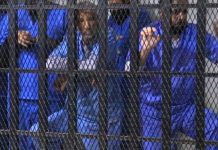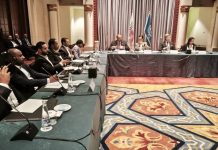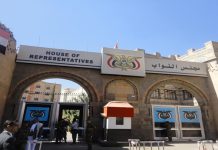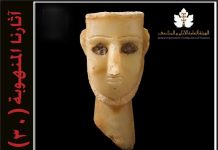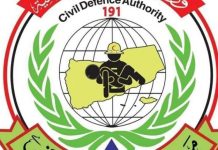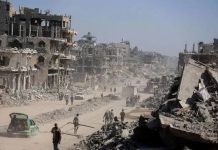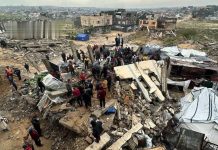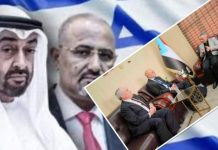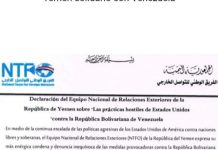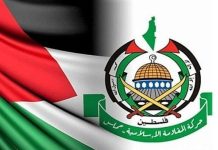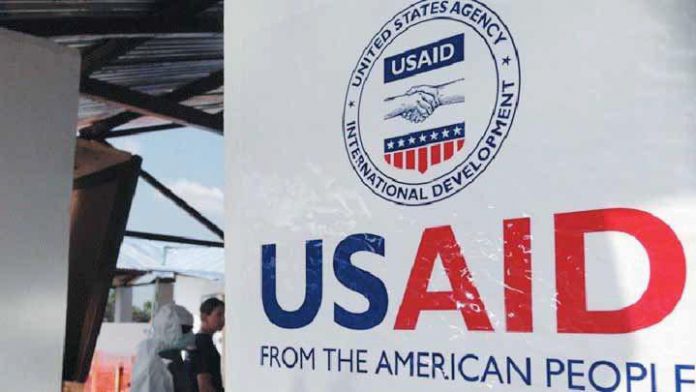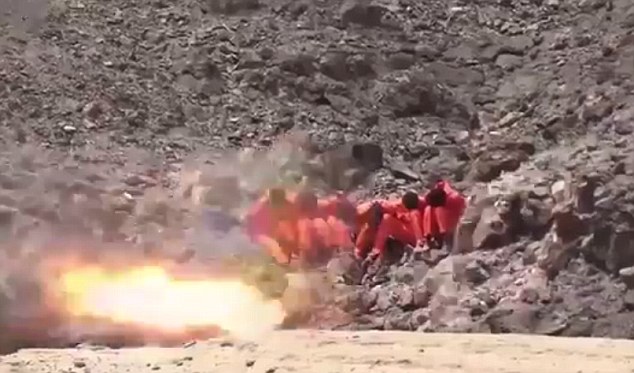Al- Thawra Net
The US flag with a phrase “Presented by the American people” that is moved by The United States Agency for International Development (USAID) in the form of flour bags, oil bottles and medicine boxes around the world, has become a gateway to plunder and control of the world.
At the same time, it is the most important arm for the US, which uses soft power in its domination, plunder and aggressive wars against various nations of the world.
Through the Agency, The US has delivered weapons and equipment to ISIS and al-Qaeda, created killing and terrorism groups that have destroyed Arab and Muslim countries, and through the agency has carried out political coups in several countries.
In the aggression against Yemen, the United States agency penetrated areas, provided information and coordinates, and provided weapons into areas that were enclaves that were difficult to access.
Since the 1950s, it has destroyed agriculture, the fish and productive sectors and conducted agreements with ministries and government agencies, through which it was able to implement the policy of impoverishment and systematic destruction of economic components, development and promotion factors.
Since it was founded in the late 1950s, USAID has served the US foreign policy, which aims to take absolute control of the world in a new way that shows as if it is building, reconstruing helping, while the internal core a war.
By Abdullqader Othman
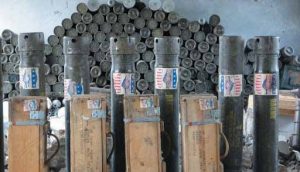
The story begins after the US President Harry Truman (1884-1972) assumed the Presidency of the United States for a second term (1949), when he set a new stage in American foreign policy on four key points, in a speech he delivered on January 20, 1949.
The first point included “continuing to support the United Nations and increasing its effectiveness and influence in global politics”,
The second point emphasized “the continuation of programs to improve the global economy by supporting the European economy and removing barriers to global trade”,
The third point included “US support for the freedom of peoples and protect them from the risk of attacks and provide the necessary military expertise and means.
The fourth point drew attention to new ideas and means that then had the effect of increasing the US influence and intervention in various countries of the world through food and health assistance programs and infrastructure projects.
Initially, the goal was to secure Western imperialism and increase its influence in the face of the Soviet tide after world war II, the mid-1940s, from which the United States emerged victorious.
Contradictions of the US Stance
As part of the US plan, the White House relied on security intelligence methods to force other forces to follow the path set by them, but also used violence against many of the forces that stood in their way.
On the other hand, the US has established itself as a guardian of humanity and a defender of rights, freedoms and the will of peoples, not only that, but also through its organizations operating in many countries, to feed crises and recruit mercenaries under the slogans of community leaders, youth, shadow governments, etc.
The demonstrations and mass movement in the United States, following the killing of African-American citizen George Floyd by a white policeman months ago, bring us back to the reality of the American system, which continued to wave the slogan of supporting the will and freedoms of peoples in order to achieve their interests in other countries.
But the US regime has crackdown people in more brutal and bloody ways than some other regimes did at the behest of the American leadership,
This reveals that those organizations that devote their efforts in developing countries and devote billions of dollars only to sever the US policy and destroy countries that are trying to build a strong economy.
In the mid-1940s, the United States felt a little away from defeating Japan, so the US dropped the two nuclear bombs on Japan, killing up to 140,000 Japanese in Hiroshima and another 80,000 in Nagasaki.
It then triumphed, emerged from the war, ascending to the throne of Western domination, and it increased after the disintegration of the Soviets, establishing the International Monetary Fund, the World Bank and the World Trade Organization, becoming the first world currency and dominating the world economy.
The US had established with the allies, the UN Organization that became a tool for implementing their policies with international legal cover, then re-recruited the media to decorate and justify its heinous violations, and to be a tool to support military coups while establishing mercenary armies to overthrow opposition governments.
Pressure and Blackmail
After the creation of The United States Agency for International Development (USAID), America had opened an office in Yemen, during the reign of Imam Ahmed Bin Yahya Hamid al-Din, specifically in 1958.
It was called the “fourth point” in Taiz, and it carried out a number of projects in the field of water, roads and health, as well as food assistance.
One of the most important projects implemented by the fourth point, is the Taiz Water Project, which is still remembered by elderly people in the province as Taiz Water Project was named Kennedy Water Project, as well as the Mocha-Taiz-Sana’a High way,” according to a report by Abbas al-Sayed, currently the Editorial Manager in al-Thawra newspaper on September 24, 2012.
However, the organization’s work in Yemen has gone through several stages that the US administration has used to blackmail the regime or as a reaction to action contrary to the directions set by its regimes.
Yemen has ruled for the past four decades, for example, when Yemen’s representative to the United Nations voted against the formation of a US-led coalition to use force against Iraq in 1990.
The US representative Thomas Pickering walked up to the Yemeni delegate’s seat and informed him that this was the most expensive “no vote”, and the Yemeni rejection resulted in the suspension of the agency’s funding to Yemen.
It did not resume its work until 2003, i.e. after the emergence of a new national movement that shouts death to America and calls for the activation of resistance in the face of American arrogance, launched in northern Yemen, led by Sayyed Hussein Badr al-Din al-Huthi, and then the agency returned to practice its work and its apparent support to Yemen.
Since then, the Agency has worked on cooperation agreements with sovereign ministries such as the Interior ministry and other major economic interests, such as the Ministry of Finance, Agriculture, Industry and Higher Education.
The agreements were malicious scenarios practiced by the agency in all the countries, but those countries uncovered the games and expelled them while Yemen stood the bait.
The Former US Secretary of State George Shultz (1982-1989), described the USAID in the introduction to the 1983 Special Report of the US Department of State as “an essential foreign policy tool, directly linked to America’s national security and economic prosperity.”
The Fourth Point
Lately – Spokesperson of the Yemeni army Brigadier General Yahya Sare’e revealed a large group of weapons bearing the logo of the United States Agency for International Development (USAID).
Those weapons were found by the army and popular committees during the recent military operations in Bayda province.
“This is the American aid to the Yemeni people and this is the reality of this organization that is trying to impose its decision on the Yemenis and exercise suspicious roles,” Sare’e said.
The army spokesman reviewed live pictures showing the 105-caliber Hauser and 75-caliber artillery shells bearing the logo of the USAID.
The USAID supports and funds foreign organizations working in Yemen to implement its activities in local communities in a number of provinces and was exercising intelligence roles under humanitarian slogans.
In fact, this is not the first time that the USAID has played a military role in Yemen, going back to the date of the September 1962 revolution, we find that ” the Fourth Point”, which if The agency’s Yemen branch witnessed the formation of one of the most important secret cells of the labor movement in Yemen within the administrative sector of its road project.
But the Arab nationalist movement had penetrated the fourth point and resulted in a close link between the movement and the workers, as stated in the “Paper at the Symposium on Documents of the Revolution Taiz Part 5” by Said Al-Janahi.
Then, after the establishment of the republican regime, the point turned into a dangerous den to conspire against the revolution in order to exploit the conflict with the monarchists.
The USAID took advantage of the many privileges granted to her, the weapons and devices she had secretly entered into the country, after it was confirmed that she had been spying and communicating with the other party.
A mass demonstration took place in Taiz denouncing the Americans and demanding the closure of the fourth point, according to Dr. Mohammed Ali al-Shahari in his book “A Look at the Issues of the Yemeni Revolution”,
In early December 1966, the Yemeni authorities arrested a number of point employees on charges of conspiring and recruiting spies against the revolutionary government and asked them to hand over the projects to officials or leave the country, as well as cutting off the radios they owned and enabling them to communicate with their agents inside and outside the country.
In mid-April 1967, the Security Services in the Raheda area arrested the American employee Richard Bejalev, who was working at the fourth point while he was coming from Aden, and found in his car three rifles, 144 rounds, a hunting cartridge rifle and a camera.
Also, on April 25, 67, security services arrested two Americans working at point four, Steve Jobs and Harold Hattman, who had fired four Bazooka shells at an ammunition depot in Taiz and at the Headquarters of the Arab Command and the Military College.
.After the attack, the government subsequently terminated the agreement between the agency and the Imam’s government and all the agreements and annexes that follow it.
Suspicious Objectives Roles
According to Philip Agee, a former Central Intelligence Agency officer said Since the USAID has been founding, it has served as a wing of the CIA.
He confirmed that the USAID agency follows three forms of hacking into community organizations around the world.
Firstly, the USAID recruits a number of political symbols of the target country in the intelligence and funds them to create the facades of civil society organizations that raise the slogans of political change, the defense of freedoms and human rights, protection of religious and ethnic minorities, the empowerment of women, transparency, etc., inspired by American culture.
Secondly, the agency focuses on supporting and funding organizations that already exist and had influence on them to take positions that serve and align with the US policies.
Thirdly, it includes moral support for organizations that raise human rights slogans in countries around the world by holding and enlisting them to participate in international conferences, recruiting their administrators as consultants and academics in the US and international institutions, with the aim of giving them influential positions in public opinion in their countries, and directing them indirectly to serve the US interests.
Among the countries that the agency worked against was Venezuela. The agency it worked with the CIA, the US Department of Defense, the National Endowment for Democracy and the Venezuelan Mafia in Miami to overthrow Venezuelan President Hugo Chavez, who was strongly against the U.S. expansion project, and was the main executor of the project.
In 2012, Russian authorities uncovered the suspicious role played by usaid, using aid and development funds in an effort to influence Russia’s political process, including elections at various levels, and civil society institutions, prompting the authorities to block the agency’s activities in Russia from October 1, the same year.
In Cuba, America, the USAID, in the mid-2000s, established secret cells in order to energize and support the opposition to overthrow the regime.
In Bolivia, in 2008, the Coca Farmers’ Union expelled 100 agency employees and contractors working in Chapare Province, on the back of projects that the Agency wanted to implement to eradicate coca and support farmers to grow other crops on condition that they give up all their coca plants, according to the ANDINA News Agency.
Shadow Governments and Civil Society Networks
In Arab countries, the USAID agency attracted community organizations and created interfaces, which later became shadow governments.
These governments have tried to influence and control the programs and plans of political, economic and social transformations in the countries.
This was exposed by the former director of campaign programs at the International Republican Institute in Egypt, Dawlat Issa.
She resigned from the institute after she had discovered that the funding, which the Institute receives from abroad, was aimed at training some of the parties founded by the Mubarak regime to carry out the plan to corrupt political life in Egypt and the coup d’état on January 25, 2011, with a time limit of up to 2015, which has already happened.
In Tunisia, the agency through the establishing of many suspicious activities, the most serious of which was targeted by the “Regional Civil Society Networks” program, to create the largest database on Tunisian society, to reverse the achievements of the revolution by promoting the American model of democracy, and to reconnect Tunisia with the US decision.
In Iraq, in 2003, the USAID agency entered during the US occupation on the back of tanks and continued to work with local and Zionist organizations to plunder Iraq’s wealth, and did not sign a labor agreement with the Iraqi government until 2012.
Its role in Yemen
It is clear that Yemen may have fallen into the agency’s earlier, if still, entanglement and walked diligently and attentively in accordance with the plans and agreements reached, but the Agency has not only sought to do so, but also sought to repeal and amend all national laws and legislation that violate it.
In particular, in relation to elections, or women’s assumption of public leadership and the judiciary, or the absolute equality of male and female and more, or the absolute freedom of women without restrictions, in addition to the comprehensive review of all laws and internal legislation, and the amendment and deleting of certain articles that contradict the objectives of the Democratic Institute promoted in Yemen.
The agency also tried to pressure the Yemeni authorities to pass what The UN’s conferences called “sexual diversity” or “homosexuality,” including amnesty international’s 2012 report on political and civil rights and its call on the Yemeni government to “repeal articles 263, 264, 267 and 268 of the Crimes and Penalties Act, which criminalize consensual same-sex relationships.”
The Agency has signed agricultural cooperation agreements with Yemen that require the support of farmers in many areas in order to promote crop diversity at the expense of coffee cultivation, which is the country’s first national and economic product, and the programmes implemented since 2004 have focused on Saada, Amran, Lahj, Hajjah, Marib and Jawf.
In addition to agreements to prevent the cultivation of wheat in Jawf and elsewhere in exchange for continued support, as well as agreements between the agency and the Ministry of Finance and joint cooperation programs, which continue to this day with the government of mercenaries, whose ministry of finance continues to renew its proxy meetings in Aden until 2018, and continues in Riyadh beyond this date.
Exploitation of Humanitarian Work
After declaring aggression against Yemen, led by Saudi Arabia and the UAE backed by The United States and Israel, since March 2015, the agency has resorted to humanitarian action on an apparent basis but has continued to hide its real work behind the robe of humanity.
Unlike areas run by the Supreme Political Council, the Agency in the occupied areas appears to be more visible.
Hadi’s Ministry of Interior had published a report about its meeting with the regional director of the USAID, Mary Eileen Devitt , at the head of a delegation of the US Embassy in Yemen, with the so-called Interior Minister there, Ahmed al-Maisari, in mid-2019.
Hadi’s minster appreciates the US role in supporting the so-called “legitimacy”, while US the Ambassador Christopher Henzel emphasizes continued support. The agency is responsible for its implementation and the provision of weapons to mercenaries and terrorist groups, as recently revealed by the Yemeni armed forces.
In the areas of the Supreme Political Council, it has used its humanitarian work to present itself in a dangerous way, enabling it to achieve security, community and cultural breakthroughs, which may explain the rejection of many of the projects it offers by the Supreme Political Council for the Coordination of Humanitarian Affairs and International Cooperation .
According to the information we have obtained in this regard, in addition to the fact that the Agency’s projects do not represent an emergency priority in the current circumstances of Yemen, and in addition to allocating most budgets to the offices of organizations and operational expenditures, they are mainly targeting areas with a small population density and considered neutral or non-reactive to provide them with sources of income and encourage them to be neutral, as well as building relationships with the leaders in these areas and allocating large amounts to some of them as salaries or privileges.
The Mercy Crops, Care and ACTED organizations operated in the provinces of Sana’a and Mahweit, and this sends a picture among citizens that these organizations provide great support to the community and the people while being taken over by these leaders, which have become counted on the Supreme Political Council.
Among the agency’s activities and other more suspicious US organizations, their focus on certain provinces and directorates which have front backgrounds.
The agency’s monitoring of these directorates allocates a large amount that may reach several programs at once and from only one donor — other than the World Food Program and some UN organizations, under the pretext of development.
When Yemen was exporting oil, for example, before 2014, the whole province of Dhamar was allocated three billion riyals.
The agency and other organizations have now allocated more than 2 billion riyals to the district of Wusab As Safil, and the district has a background for a military front.
Two projects of the same fund were implemented through another organization that started in 2017, while the Manakhah District has allocated more than three billion riyals.
In light of this great revelation, which showed the suspicious role of USAID, becoming America’s hidden hand for the military, social, economic and moral destruction of Yemen.
The same question is raised again to the public: Will Yemen follow the example of other countries that have cancelled cooperation agreements with the AGENCY, expelled its staff and suspended its activities once and for all? Or will the agency continue to have fun in the country as it pleases? The Yemeni authority has to answer this question.
Translated by Emad al-Marshahi
Source: Al-Thawra Net

